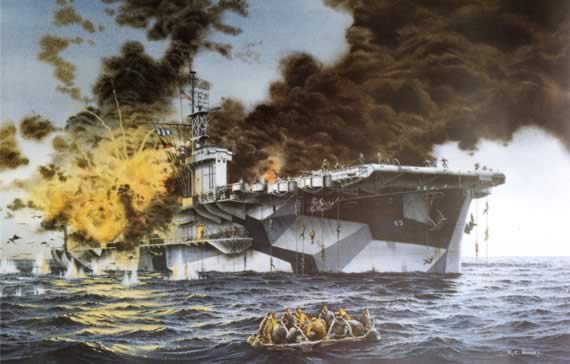
Sometimes vindication comes quietly – as, say, a couple of years later in part of an interview and provides demonstrative proof that there is a core group that ‘gets it’:
“In a Nov. 15 interview with ITN, Morgan said that when Navy officials wrote the NOC in 2006 “we knew we were doing the process in a backwards way.” “Here we had this operating concept before we had the strategy, and now that we’ve got the strategy in place what we want to do is sort of put the horse back in front of the cart,” he said. “We want the strategy to lead.” (emphasis added)
Amen? Amen…
In the same article, VADM Morgan outlined what the new NOC hopes to accomplish:
“What that will do is it will take the maritime strategy and then explain for Marines and sailors everywhere what mission we’re going to perform to support the strategy, and in general terms, how we’re going to operate,” he said. “So we will begin to implement the maritime strategy by explaining how we’re going to operate.”
This is the point where the process gets interesting, i.e., the intersection of rice bowls and sacred cows. At the higher levels of the strategy document, one can afford to be vague, or perhaps more fairly, to be more generalist in nature. As one works down from the strategy document, the language must become more precise, more detailed and specific.
This process will actually yield two documents of note – both the aforementioned NOC and the Naval Strategic Plan or NSP. The NOC provides the “how” while the NSP provides the “with what” that fills in the details left open by the Maritime Strategy. For example – take ballistic missile defense. Maritime BMD was listed explicitly in the new MS as a component of deterrence:
“Maritime ballistic missile defense will enhance deterrence by providing an umbrella of protection to forward deployed forces and friends and allies while contributing to the larger architecture planned for defense of the United States”
Let’s break that down as to how it may be addressed in both the NOC and NSP.
Obviously, an enhanced defensive capability (which, one hastens to add, would include both offensive (e.g., prompt strike) and defensive forces) against ballistic missiles would give an opponent pause to consider the likelihood of success in carrying out an attack. Such is the calculus of deterrence.
There are two variants of BMD – at work here, theater and national missile defense. Both rely on specially configured/modified Aegis cruisers and destroyers. Theater defense would rely on these specially configured Aegis ships for surveillance, tracking and engagement of theater ballistic missiles – primarily of the SRBM and MRBM variety. Engagement would be via the SM-3, purpose built for BMD, or, in limited cases, SM-2 blk 4. The NOC would go about describing in general terms the role the Aegis BMD ship will play in theater defense, how it would plug into the JFACC and JFMCC, something about the C4I architecture, etc. Information of greater granularity (the “how to” for system set-up, surveillance plans, shot doctrine, etc.) would be found in tactics publications that would, of course, be written at a higher classification level. Similarly, an Aegis BMD ship has a significant role to play in the National Missile Defense system, primarily as a surveillance/tracking platform due to the IR/ICBM-type targets and current SM-3 capabilities in question. With Block II variants of the SM-3 envisioned for use in the near future, they will play an engagement role in a NMD scenario as well. And there, the NOC also plays a role in describing how Aegis BMD plugs into the NMD architecture as well as its relationship with the other elements of the NMD.
While the NOC describes the operational concept for this weapons system, including its integration and relationship with others, the NSP gets to the meat of the force structure argument. It provides the answer, influenced by the MS, of “how many” and “why that many.” There are a finite number of Aegis ships and an even smaller subset (currently) of Aegis BMD configured ships. Ditto for numbers of missiles. There is a finite (and shrinking) amount of money in the POM for ships, aircraft, missiles, etc. The NSP lays out the strategic plan for why X-number of Aegis BMD configurations will be put in place and SM-3’s produced. At the same time it also details why there is a requirement for y-number of F/A-18F AESA kits, LHA’s, etc. With that document, and in concert with COCOM priorities lists, a clear course to a sound force structure could be charted. Note the operative “could.” Unfortunately it is not immune to Congressional earmarks and other budgetary pressures. However, unlike years and NSP’s past, this one will at least have a firm basis in a strategy document that appears to have buy-in, which in turn, would serve to make justification of adding undesired or unplanned systems to the procurement line harder to justify than when there was the absence of a strategy.
From personal experience of having to work on both documents in the 2001-04 timeframe, our hands were notably tied by the absence of a current, viable and credible strategy. It had the effect of ensuring both documents were DOA – if they even made it to final draft. It would appear the next iterations will not suffer that fate – provided they make it through the wicket of competing requirements amongst the three maritime services (and primarily between the Navy and Marines). Therein lays the test – to see if the alliance forged for the new MS will remain intact.
Finally, there is the issue of classification. We hope and strongly encourage the authoring agencies that both documents be available, in redacted form if necessary, as unclassified documents. In doing so they will serve to continue and influence the national dialogue over the future of our maritime services and capabilities. –SJS



2 Comments
Comments are closed.